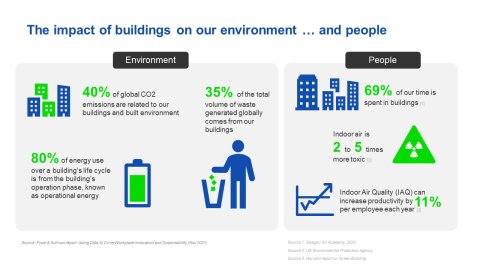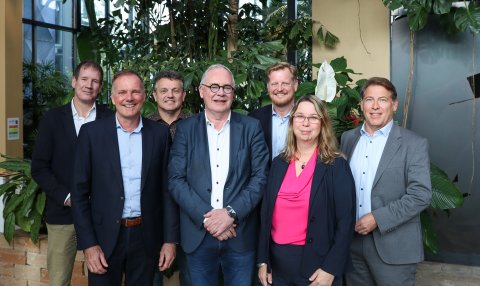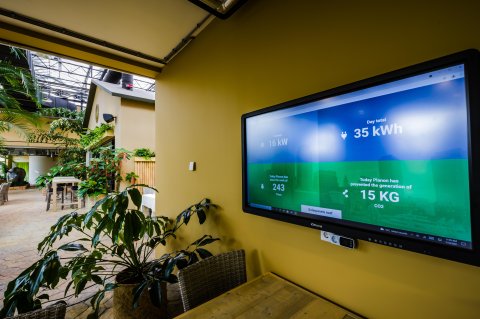
Table of Contents
- Sustainability is now a strategic imperative for all companies
- What is ESG?
- How to define your strategy for sustainable buildings?
- What is the impact of buildings on our environment and people?
- What drivers of ESG initiatives are most important to organizations?
- What do sustainability standards mean for your business?
- Why technology and data play a crucial role in achieving sustainability commitments
- How to start or accelerate your sustainability journey?
Sustainability is now a strategic imperative for all companies
Sustainability has moved beyond just green intentions. Organizations are increasingly understanding the value of commitments on sustainability and the risks of neglecting it, and are integrating it into their business strategies. With the introduction of new environmental, social and governance (ESG) regulations in many countries, sustainability is now a strategic imperative.
What is ESG?
ESG stands for "Environment, Social, and Governance." It is used by companies and investors to assess how a company addresses sustainability in a broad sence. The assessment closely examines and rates an organization's responsibilities in terms of environmental impact, social practices, and corporate governance.
The E stands for 'environment' and assesses how an organization is dealing with environmental risks and natural resource management. The E in ESG goes beyond measuring the amount of energy or raw materials a company consumes. It also deals encompasses the treatment of water, air and VOC's.
The 'S' in ESG) encompasses the proper treatment of human capital, ranging from employees to contractors. Does the organization ensure sufficient equality, diversity, and safety within its ranks? Additionally, the 'G' in ESG rates aspects such as executive compensation, internal hierarchy, corruption prevention, and financial structure contribute to the overall policy and financial corporate governance.
Why is ESG so important now?
Using an ESG approach to sustainability will enable organizations to develop formal sustainability performance management, measurement and disclosure practices. These practices must comply with specific regulations and are part of a strategy to drive sustainable growth, efficiency, and organizational resiliency. This will be critical as more organizations set measurable targets related to voluntary and mandated sustainability strategies.
Company challenges are closely linked to all the dimensions of Environmental, Social and Governance (ESG). On the Environment dimension it is about resource efficiency and reducing consumed energy and carbon footprints. On the Social dimension it is about employee health & safety and the war for talent. The Governance dimension is about achieving compliant & sustainable business growth.
ESG focus areas for the built environment
Environment
- Resource efficiency
- Renewable energy
- Carbon emissions
- Value & supply chain
- Transportation
Social
- Health
- Safety
- Wellbeing
- Comfort
- Workplace experience
Governance
- Compliance
- Risk management
- Project management
- Building certifications
- Reporting
How to define your strategy for sustainable buildings?
If you have found your way to this page you may not be a stranger to the topic of sustainability in real estate, facilities management, or building services. You may be under pressure to define a strategy for your organization or support a client in defining their own strategy. Whether you are a real estate owner, occupier, or facility service provider – this page should be your first stop when formulating an appropriate sustainability strategy within the scope of the built environment.
A global Planon ESG research study targeting over 600 building owners, occupiers, and facility service providers confirmed the importance of ESG on organizations’ agendas. The research reveals that 53% of businesses have defined ESG commitment targets, but only 33% have an ESG performance governance plan in place. Notably, 43% of service providers responded that they have been asked for an ESG proposal by their customers. This highlights that many companies have defined goals and targets, yet they still do not have a clear path towards reaching them.
What is the impact of buildings on our environment and people?
Buildings are one of our most important and most wasteful resources. Most sources today agree that around 40% of CO2 emissions and more than 50% of electricity consumption is from our buildings. On top of that, buildings account for around 35% of waste production and provide a working environment for more than 75% of the global workforce.
The way we manage our buildings impacts our environment and people. This is a major opportunity for facility managers and service providers to contribute to a more sustainable future. This is achievable through improving the operations and efficiency of high energy consuming assets in the built environment, such as heating systems and air conditioning units, as well as the productivity and well-being of the people using the buildings. Additionally, the environment also impacts buildings, and these increased climate related risks require a strategy to ensure a resilient built environment.

What drivers of ESG initiatives are most important to organizations?
Sustainability has already become a key factor in how we do business. Stakeholder pressure on ESG commitments, employer branding, increased recognition from the C-level of ESG value and risks, and new climate disclosure regulations are some of the major driving forces for ESG commitment among organizations.
Planon ESG research reveals that the vast majority of businesses in North America and Europe have ESG initiatives in place for a more sustainable building portfolio, but that the drivers guiding these initiatives differ across building occupiers, investors, and service providers. There is a clear focus among survey respondents on ‘reaching ESG commitments’, ‘increasing transparency and accountability’, as well as on being able to ‘offer ESG services to customers’.
Biggest ESG drivers
Real estate investors
40% ranked ‘reach ESG commitments’ as the number 1 driver for their ESG initiatives
Building owners/occupiers
32% ranked ‘compliance’ as the number 1 reason behind their drive towards ESG initiatives
Facility service providers
36% ranked ‘offer ESG vision/strategy services’ as their number 1 driver for ESG initiatives - highlighting their focus to support their customers on ESG
What do sustainability standards mean for your business?
Besides the need to adapt to shifting market sentiment on ESG performance, the regulatory landscape is also shaping the way companies act on ESG and sustainability. Several mandatory climate disclosure rules will soon come into force. They aim to ensure that companies disclose comparable, relevant and reliable sustainability information. Moreover, they strive to steer us away from the alphabet soup of the current variety of reporting standards.
As of 2024, EU firms will have to report on their environmental and social impacts under the Corporate Sustainability Reporting Directive (CSRD) or the Sustainable Finance Disclosure Regulations (SFDR) for real estate investors. For UK companies the Climate-Related Financial Disclosures (TCFD) has already come into effect. Similar tightening of ESG regulations will happen in the US according to proposed SEC climate risk disclosure rules.
Add to these regulations, the voluntary frameworks to assess ESG performance and the green building certifications that buildings can achieve to show environmental performance (like BREEAM, Energy Star, LEED, and GRESB). Furthermore, there are also certifications focused on the health,
Why technology and data play a crucial role in achieving sustainability commitments
Since the way we manage our buildings plays such an important role in achieving the ESG goals organizations are committed to, then it is beyond dispute that data management on ESG performance is essential.
For facilities, this often means capturing and analyzing real-time and historical data, ideally from one integrated system. The technology is already there and evolving fast, for example, the promising Digital Twin technology for smart buildings.
Nowadays, building management software is widely used for supporting building operations and facility management processes. This software category is also known as property management software, facility services software, or integrated workplace management systems (IWMS). Generically, they provide the capability to structure and manage the physical, operational and financial details about buildings, spaces, assets, equipment, disposables, organisational units, people and related workflows.
By nature, these platforms are also systems of data governance, because they structure data, ensure its integrity, control its use and transformation (with workflows), and as a result, will yield consistent, accurate data for reporting and disclosure. This process is already applied to static data, now also for real-time data.
With the right analytics and intelligence layer on top, connections with other systems (ecosystem), and extended with Internet of Things (IoT) technology, data can truly optimize the efficiency of resources (Environment). In addition, it can improve the experience of building users (Social) and support in proving control for reporting and sustainability auditing purposes (Governance).
Learn more about sustainability for buildings

Why IoT plays an essential role in achieving sustainable facilities management
IoT is one of the major technological forces enabling organizations to achieve more sustainable management of their building operations and facility services.
Learn more
Managing the impact of buildings on our environment
Read about 8 transformational technologies and trends leading the way to more sustainable facility management in this report from Frost & Sullivan.
Read more
10 Reasons Why Service Providers Should Adopt Sustainability
As organizations all over the world are trying to reduce their carbon emissions, the role of facility services providers in meeting reduction targets grows.
Read moreHow to start or accelerate your sustainability journey?
Sustainability is here to stay. Whether you want to achieve competitive advantage or have a risk and compliance focused approach to ESG and sustainability, the question will be how to integrate sustainability into your or your clients’ business strategy. Therefore, you will need to address several factors that include:
- What do your stakeholders expect from you?
- What regulatory compliancy concerns do you have to address?
- What are the impact areas where you can make the biggest difference?
- Do you have the right data sets, processes, and technologies in place?
- How to drive and manage improvement programs for cost, efficiency, and experience?
Effectively, real estate investors, facility managers, and service providers have the power to reduce the impact of buildings on the environment and lead the ESG transformation towards more livable and sustainable buildings.
Find out how you can make an impact with sustainable facility management solutions.
Learn more about Planon sustainability software for buildings

IoT | Internet of Things
IoT and IWMS allow you to capture, analyze and utilize building data, resulting in a proactive facilities management operation and more efficient use of assets
Learn moreIntegrated Workplace Management Solution
Achieve great organizational performance through improved cost efficiency, quality in processes, and support sustainability goals with our IoT-enabled IWMS.
Learn moreFacility Services Business Solution
Connect with your customers towards stronger relationships through transparent communication, efficiency and innovation with our Facility Services Business Solution.
Learn more





















